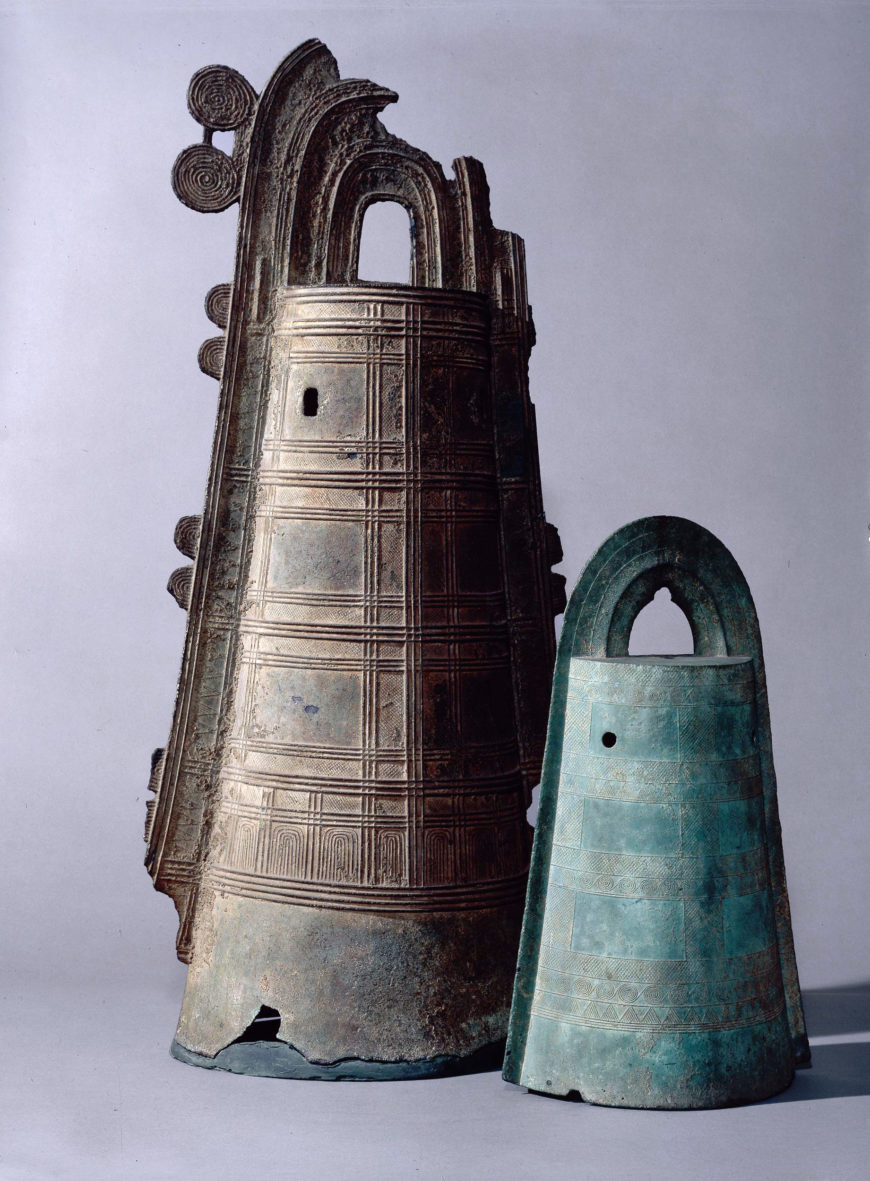Dōtaku (bell-shaped bronze, national treasure), 1st–2nd century B.C.E., bronze, found in Kagawa Prefecture, 42.7 cm high (Tokyo National Museum). A conversation with Dr. Beth Harris and Dr. Steven Zucker.

Two dōtaku (ritual bells), 200 B.C.E.–200 C.E., Yayoi Period, bronze, Japan, 59.7 cm high (© Trustees of the British Museum). The larger bell on the left is mentioned in the publication Dōtaku Kozu (1822), where it says it was discovered in Wakayama Prefecture in the collection of Kishi Seiichi.
The origin of the dōtaku is thought to be the Chinese cattle bell. However, the Japanese did not practice cattle farming, so the first bells must have been imported as ritual objects. The fact that they are often found buried on isolated hill-sides and show evidence of having been buried and dug up several times, suggests their use in an agricultural ritual. Dōtaku were cast in moulds made up of pieces of stone carved with decorative patterns. Some of these stones have also been excavated. The earliest bells have suspension rings and clappers. These rings gradually became larger, and part of the bell’s overall design. The clappers only produced a muffled tone, underlining the fact that these were ritual objects not intended to be rung.
The delicate decoration on these bells resembles that found on contemporary Chinese mirrors. Later bells were decorated with scenes of animals and humans hunting or farming. Bells up to twice this size have been found.
© Trustees of the British Museum
[0:00] [music]
Dr. Steven Zucker: [0:04] We’re in the National Museum of Tokyo, and we’re looking at a bronze bell, which was made by one of the oldest known cultures in the prehistory of Japan.
Dr. Beth Harris: [0:14] This is a period called the Yayoi. It’s certainly a bell shape. Some of these had a clapper inside, but we think that they primarily had a ritual purpose since most of them did not.
Dr. Zucker: [0:26] Bronze casting technology, casting molten bronze in a clay mold, likely came from either China or Korea, and perhaps the shape, also. These began as small objects, and they grew into a variety of sizes.
[0:38] They’ve been unearthed at a number of different sites, but what’s interesting is that we find them alone. They’re not part of a larger cache of ritual objects.
Dr. Harris: [0:48] Sometimes up to 10 in a single burial place, and there are regional differences. Sometimes they have fin-like shapes on the sides. The example that we’re looking at doesn’t.
Dr. Zucker: [0:59] This example is exceptional because it has 12 pictorial scenes within it. These are some of the oldest pictorial scenes that we have from Japan.
Dr. Harris: [1:07] This is the beginning of the Bronze Age. Although settled communities had existed in the Jōmon period, during the Yayoi period, there are settlements where humans start engineering the landscape for agriculture. They start creating rice paddies. There’s an ability to have the population thereby increased to have a more hierarchical or stratified society.
Dr. Zucker: [1:29] The name Yayoi refers to an area near Tokyo, where the first Yayoi objects were found, but these are not the first Yayoi objects. It’s just circumstance that this culture gets this name. Let’s take a look at the 12 scenes. They’re simplified, but the casting technique made the images quite clear.
Dr. Harris: [1:47] It’s interesting to see figures and animals when so many other objects from this period and earlier are purely decorative.
Dr. Zucker: [1:54] One of the images that I find most interesting is an image of a house. It’s a high house on stilts, and it’s got a ladder that goes up. You can see that the floor is quite high, and then you can see the wood slats that construct the roof.
Dr. Harris: [2:07] It’s hard to find a theme that unifies these different images, because right next to that we see a scene that seems to depict two figures, each with a pestle, with a mortar between them, grinding something.
Dr. Zucker: [2:19] We also see hunting scenes.
Dr. Harris: [2:20] We see a figure who seems to be seated, because his legs are bent forward at the hip, or maybe jumping or dancing. His torso almost facing us although his legs are in profile, and his arms stretch out. One arm seems to have an implement in it.
Dr. Zucker: [2:35] It’s not immediately recognizable. The shape of the bell itself, its profile, is similar to the shape of the huge tombs that a slightly later culture will produce.
Dr. Harris: [2:46] The decorative forms that we see around the semicircle at the top are lovely. We see triangles, zigzag shapes, we see circular, spiral shapes, and then in the bands in between the pictorial scenes, we see a checkerboard pattern.
Dr. Zucker: [3:03] Now, none of this is incised. This was all the result of the clay molds from which it was cast.
Dr. Harris: [3:08] It’s important to remember that bronze casting is a very complicated process. You’d have to marshal a lot of resources in order to create an object of this kind. This was an important object. It was buried, probably ritualistically. It probably had a ritual function, perhaps related to the idea of prosperity in agriculture and in hunting.
Dr. Zucker: [3:30] We’re so lucky to have this bell. Its images, its shape, its form, its technology, gives us access back to the earliest history of Japanese culture.
[3:39] [music]

